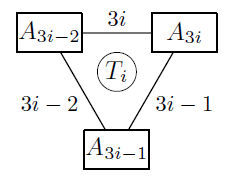Cards. Why Does It Have To Be Cards?
 On each of
cards is written a unique number, i.e. all of the numbers are different. The cards are flipped face down (the numbers cannot be seen). In one go Andrei can choose ten cards, and Kostya (who knows what the numbers on the cards are), will tell him one of the numbers (Andrei will not know which one).
On each of
cards is written a unique number, i.e. all of the numbers are different. The cards are flipped face down (the numbers cannot be seen). In one go Andrei can choose ten cards, and Kostya (who knows what the numbers on the cards are), will tell him one of the numbers (Andrei will not know which one).
What is the largest for which Andrei can guarantee to find cards and know which number is written on the back of each one?
The answer is 1986.
This section requires Javascript.
You are seeing this because something didn't load right. We suggest you, (a) try
refreshing the page, (b) enabling javascript if it is disabled on your browser and,
finally, (c)
loading the
non-javascript version of this page
. We're sorry about the hassle.
How many cards would Andrei not be able to all identify? My proposition is as follows:
Proposition: It is not possible to identify 1 9 8 7 = 2 0 1 3 − 2 6 cards. This can be proven. We number the cards A 1 , A 2 , … , A 2 0 1 2 , A 2 0 1 3 , and write the numbers 1 , 2 , … , 2 0 1 2 , 2 0 1 3 on them respectively. We ask ourselves the question: can Kostya answer in such a way that Andrei would not be able to identify the numbers on cards A 1 , A 2 , … , A 2 7 ?
We can create a graph on the numbers 1 to N based on how Kostya relabels the cards, so a directed edge is drawn from x to y if card x is relabeled with the number y . It is clear this graph will be a bunch of disjoint cycles of length at least 2 since every card is relabeled. Suppose that Kostya creates a graph for his permutation consisting of 9 disjoint cycles of 3 . For every i = 1 , 2 , … , 9 let us group the cards into triples T i like so: A 3 i − 2 , A 3 i − 1 , A 3 i will be cards in this triple. Now since Andrei selects 1 0 cards, he will pick 2 from the same triple by the Pigeonhole Principle (we have 9 triples and, since we pick 10 cards, this follows) , and these will be connected with a directed edge since cycles are length 3 . So Andrei will pick x and y such that x is relabeled with y . Kostya will call out the card on the line between these two cards, and this works for the original set of 1 0 cards since Andrei picked y , and it works for the relabeled set since Andrei picked x , so Andrei cannot get the card (as shown on the image).
We notice that if on the cards A 1 , A 1 , A 1 stand the numbers 3 , 1 , 2 (and not 1 , 2 , 3 ) respectively, our answer will not change. Thus, there is no "uniqueness" in the triples, and we would not be able to identify any of the numbers on the cards. □
Now, we only need to prove that we would be able to identify all k cards, where k < 1 9 8 7 . This we will show by proving that by asking all possible questions about 2 8 cards, then by the answers we will be able to identify the number on one of them and, subsequently, on all of them. For this we need the following lemma:
Lemma: Let's imagine that in a graph where vertices represent the cards there are at least 3 n − 2 vertices and no more than 3 n − 2 edges ( n ≥ 2 ). We shall then be able to find n vertices between which there are no edges.
Proof: Induction on n . First of all, we notice that we can eliminate several vertices and add several edges to make both of these appear 3 n − 2 )times.
Base When n = 2 on 4 vertices we must have less than 6 edges, which means that one pair of points isn't connected. We can then choose this pair.
Induction: We shall name the number of edges leading to each of vertex d 1 , … , d 3 n − 2 , then d 1 + ⋯ + d 3 n − 2 = 2 ( 3 n − 2 ) . Therefore, we shall either find a number d i = < 2 and a number d j > 2 , or every vertex is connected by two edges. In the first instance, we eliminate from the graph the i -vertex and the j -vertex, as well as the sole neighbour of i -vertex (if it exists); we eliminated no more than 3 vertices and no less than 3 edges. In the second instance let us eliminate any vertex (let its number be i ) and its two neighbours; since their degree is 2 , we eliminated no less than 3 edges and exactly 3 vertices. By induction, in the graph that still remains there will now be n − 1 vertices with no edges between them-adding the i vertex, we get the required collection of n vertices (since we eliminated i 's neighbours).
Back to the problem. Imagine that we asked all questions about 2 8 cards, and let the numbers appearing in the answers be c 1 , c 2 , … , c n (for k ≤ 2 8 ). For every i = 1 , 2 , … , k we shall look at all the 1 0 cards for which we got the number c i ; we shall call their intersection S i (this set is not empty, for it contains the card with the number c i ). If there is only one element in this set, then that is the card with the number c i on it, and we have identified it.
In the worst case scenario, in each of the sets of intersection there are at least 2 elements. For every i we shall choose two cards in S i and connect them with an edge. We shall have a graph in accordance with the lemma for n = 1 0 , and in it, we can choose 1 0 cards with no edges between them. The answer for these ten points will be some number c i . Therefore, in these ten points there will have to be a set S i , which implies that 2 of the 1 0 cards are connected by an edge. A contradiction, meaning that there is no worst case scenario!
So the answer is t = 1 9 8 6 .
Alternatively, suppose there are 2 8 cards. Consider the graph which we discussed in the beginning. Notice that if Andrei can select 1 0 cards that are not joined by an edge in the graph, he will be able to name every single one of them.. Note that for an odd cycle of length 2 k + 1 Andrei can pick k disjoint cards and an even cycle of length 2 k Andrei can pick k . Therefore, Andrei can pick 2 2 8 − C cards where C is the number of odd cycles in the graph. Since each odd cycle is of length at least 3 , and we can have no cycles of length 1 , we must have C ≤ 8 , so Andrei can pick 1 0 cards not joined by an edge, which proves our claim.
Similar Problems : The following problems are either similar or use the same methods and principles.
Bribe The Friend
Bribe The Friend Again
100% Natural